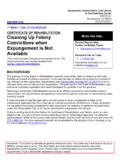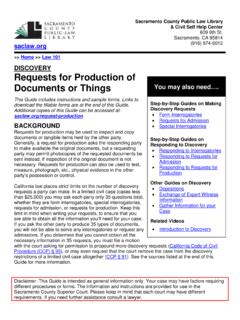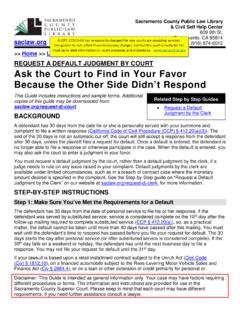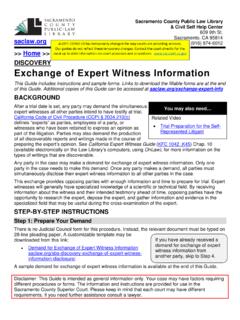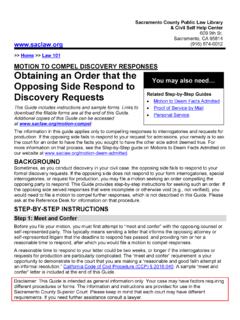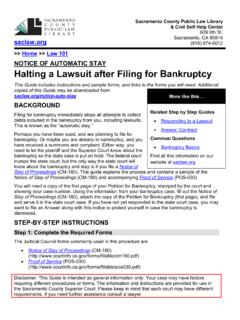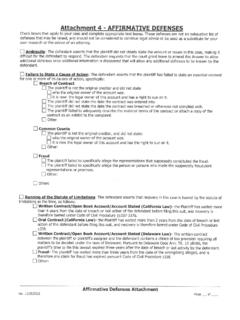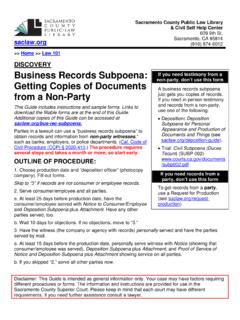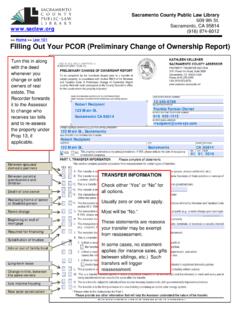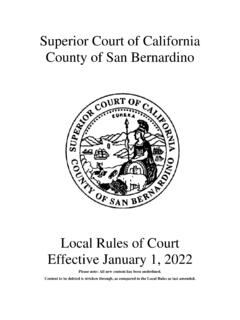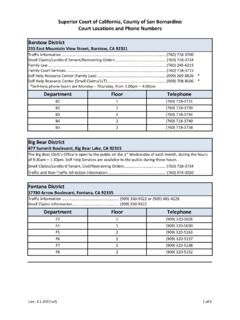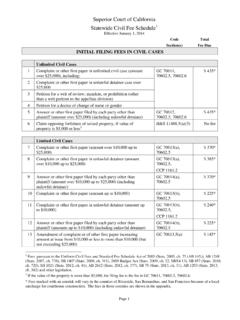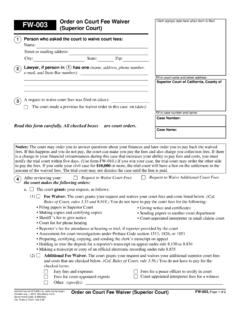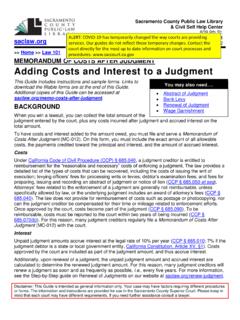Transcription of Requesting an Ex Parte Order - Home | saclaw.org
1 >>Home >> Law 101 Warning: This is a complicated procedure with many steps, and you will be expected to follow all the same rules as a lawyer would. You will need to do extensive research and writing, go to court , and speak in front of the judge. If you cannot or prefer not to do these tasks, you should hire an attorney. Sacramento County Public Law Library & Civil Self Help Center 609 9th St. Sacramento, CA 95814 (916) 874-6012 Requesting AN EX Parte Order (CIVIL CASE) Ask the court for an Order as Quickly as Possible Note: This Guide covers generic ex Parte (emergency) requests in civil cases.
2 If you need a temporary restraining Order , see our guide TROs: Applying for a Temporary Restraining Order in a Civil Case. Family, probate, and criminal courts handle the process differently. BACKGROUND Ex Parte is a Latin legal term for from (by or for) one party. An Ex Parte Application is used by one party to ask the court for an Order , such as an Order changing a hearing date or deadline, without the usual notice to the other parties to give them time to prepare an opposition. Ex Parte applications are used in emergency situations when there is not enough time for a standard motion, which typically take about four weeks (16 court days minimum).
3 Related Guides: Filing a New Civil Case Fee Waiver Guide Motions in Civil Cases TROs: Applying for a Temporary Restraining Order in a Civil Case Use only when truly necessary Because the notice requirement of motions are designed to ensure the fairness of the procedure, ex Parte applications, which by their nature circumvent this process, are highly disfavored, and granted only if absolutely necessary. If a matter could have been handled by a noticed motion or stipulation, the judge will deny your application and set for a hearing at a later date Therefore, before filing an ex Parte application, ask the other party(s) if they will agree to your request.
4 If they do, file a stipulation instead. Some types of requests are never handled ex Parte Courts in different counties may have different local rules or practices on what matters can be handled via ex Parte hearings. For example, in Sacramento, the court will reject all ex Parte applications to continue a trial. However, you may apply for an ex Parte Order shortening time, to permit you to file and serve a motion to continue trial with less than 16 days notice. Some requests are always handled ex Parte Some requests are so routine and noncontroversial that the Judicial Council or local courts have created forms for them.
5 For instance, in Sacramento, you can use a local form (see list at ) to substitute newly-discovered defendants for your Doe defendants, extend the time for arbitration, and to extend the time to select a trial date. Judicial Ex Parte Applications >>Home >>Law 101 2 Council form CM-020 is an ex Parte application to extend time to serve pleadings and other orders ( ). However, there are no pre-printed forms for most civil ex Parte situations. Researching and writing the papers You will need to research and write (1) an Ex Parte Application, stating what you are Requesting and when the hearing will be; (2) a Memorandum of Points and Authorities, explaining the relevant laws and how they apply to your facts; (3) a Declaration under penalty of perjury explaining of the facts of the case, and why the matter is so urgent it should be heard ex Parte ; and (4) a Declaration re Notice explaining if and how you give notice to the other parties.
6 (Sometimes this is combined with the Declaration of the facts of the case.) You must also write a Proposed Order for the judge to sign if s/he agrees. The Law Library has several books with samples and instructions of all these papers, which you can customize for your situation. See the Secondary Sources and Forms section, below, for specific recommendations. Scheduling the hearing and notifying other parties The applicant must schedule the ex Parte hearing ahead of time with the court department. You must also file your paperwork prior to 10 the day before the hearing.
7 In Sacramento, different departments hear different types of motions, including ex Parte applications on those matters: The Presiding Judge (Dept. 47) hears all motions for consolidation, coordination, severance, bifurcation, intervention, pretrial conference, change of venue, or to advance or continue trial. Case Management Program* (CMP) judges (Depts. 30 and 36) hear all CMP motions, including matters regarding judicial arbitration, redesignation of a case, for extension of time to answer a complaint, for relief from CMP rules, or certification for short cause.
8 Law and Motion: Department 53 (odd-numbered cases) or Department 54 (even-numbered cases) hear most other types of motions. If a judge has been assigned to a case for all purposes, that judge hears all motions for the case. These assignments change from time to time, so check the Quick Motion Checklist at for a current list of which department hears which types of motions. You must give the other party(s) notice before 10 the day before the hearing, unless you can prove exceptional circumstances that justify a shorter time for notice.
9 Ex Parte hearings have unique notice procedures. You personally should phone the other party(s) (or their lawyer, if they have one) * The Case Management Program mostly applies to unlimited civil cases. Ex Parte Applications >>Home >>Law 101 3 to tell them what you are asking the court and when the hearing will be, and ask them if they plan to attend. california Rule of court ( CRC ) If you do not reach them, leave a detailed message with a reliable call-back number. After you do this, you must write the Declaration re Notice stating whether the opposing party is represented by counsel, whether that party has been contacted and has agreed to the requested Order , or why the Order should be issued without such notice.
10 This Declaration must be submitted to the department before 10 the day before the hearing. You must also pay the filing fee (usually $60 in Sacramento) unless you have a fee waiver in the case. Attending the hearing Be sure to arrive at the appropriate department early. Bring a copy of all paperwork to the hearing with you. Pay the fee if you haven t yet, and bring the receipt to the hearing. In Sacramento, the judge will typically consider the matter in chambers (the judge s office), based on the papers you have turned in, and may just notify you of the decision while you wait.
